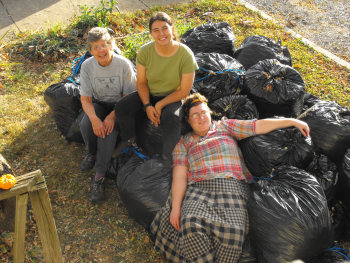
Leaves as a soil amendment
 Guatemalan farmers harvest vast quantities of
fallen leaves (broza) out of
nearby woods to incorporate into their soil. Wilken estimates
that farmers rake up leaves from 5 to 8 acres of forest for each acre
of crop they cultivate, although he hastens to add that farm fields are
small. Some farmers just hoe the leaves directly into their
soil, while others use the leaves as animal bedding for a week, then
incorporate the poopy bedding into the soil. The latter method is
especially effective since nitrogen in the manure and urine offsets the
nitrogen lost during the initial stages of leaf decomposition.
Guatemalan farmers harvest vast quantities of
fallen leaves (broza) out of
nearby woods to incorporate into their soil. Wilken estimates
that farmers rake up leaves from 5 to 8 acres of forest for each acre
of crop they cultivate, although he hastens to add that farm fields are
small. Some farmers just hoe the leaves directly into their
soil, while others use the leaves as animal bedding for a week, then
incorporate the poopy bedding into the soil. The latter method is
especially effective since nitrogen in the manure and urine offsets the
nitrogen lost during the initial stages of leaf decomposition.
Leaves are an especially intriguing soil amendment for our farm since
they improve soil structure and water retention/drainage in clayey
soils. In fact, Guatemalan farmers use leaves primarily in clay
soil, while they tend to lean toward manure in sandy soils.
Last year, I begged my city-living family members to scavenge bags of
leaves left on the curb, and we ended up with 31 big garbage bags
full. I used them as mulch around our berries and trees, but I
could have used about ten times as much leaf matter. Since we've
decided to buy firewood this year, maybe we'll have enough free time to
rake masses of leaves out of the woods and use them as soil
amendments. I may experiment with using our chicken tractors as
leaf-shredding and manure-amending factories, or may try to harvest the
nitrogen in our urine by peeing on our leaves. Stay tuned for
lots of leafy experimentation this fall and winter!
| This post is part of our Central American Permaculture lunchtime
series.
Read all of the entries: |
Want more in-depth information? Browse through our books.
Or explore more posts by date or by subject.
About us: Anna Hess and Mark Hamilton spent over a decade living self-sufficiently in the mountains of Virginia before moving north to start over from scratch in the foothills of Ohio. They've experimented with permaculture, no-till gardening, trailersteading, home-based microbusinesses and much more, writing about their adventures in both blogs and books.
Want to be notified when new comments are posted on this page? Click on the RSS button after you add a comment to subscribe to the comment feed, or simply check the box beside "email replies to me" while writing your comment.
